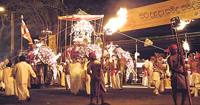
| News Updates : |
About Sri Lanka 
. Click locations on the Sri Lanka map

|
| Back to Top |
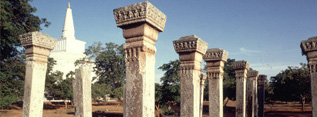
The capital of Sri Lanka from the 05th Century B.C. to the end of the 10th Century A.D. was the most celebrated of Sri Lanka’s ancient ruined cities. The city’s greatest treasures are its dagobas constructed of bricks and hemispherical in shape. The most notable of these dagobas are the Ruvanveliseya which dates back to the 2nd Century B.C. and is 300 feet in diameter, the Jetawanarama is 370 feet and the Thuparama Dagoba enshrines the collarbone of the Buddha. The city’s most renowned relic is the sacred Bo Tree, which is said to have grown from a branch of the tree under which the Buddha gained Enlightenment. It was planted 2250 years ago and is the oldest historically authenticated tree in the
Avukana Buddha Statue
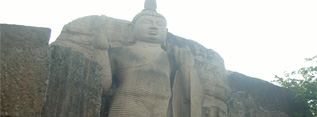
Undoubtedly, the most magnificent undamaged ancient image in the island. This 5th Century statue, ascribed to King Dhatusena, is 46 feet high, standing in an image house of which remains could be seen. It is situated 32 miles
(51 kilometers) southeast of Anuradhapura via the great tank of Kalawewa.
This is the most beautiful Rock-cut standing Buddha Statue in the Island, if not the entire world.
Mihintale
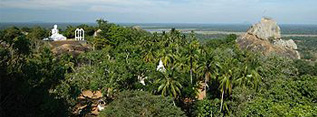
140 miles from Colombo, 8 miles from Anuradhapura. Mihintale is called the “Cradle of Buddhism in Sri Lanka”- it was here that the Buddhist doctrine was first preached in here by the monk ‘Mahinda’, son of Asoka, Emperor of India, to King Devanampiyatissa more than 2000 years ago. Mihintale - ‘the hill of Mahinda’ is approached by a magnificent, wide, ancient stone stairway of 1,840 steps.
This is the World’s first declared sanctuary from 247 B.C. and continues to be one up to this day.
Some of the monuments found here are the oldest in the country and the large number of Brahmi inscriptions dates from the 3rd century B.C.
Kantaka Cetiya, Ambastala Dagoba, Maha Thupa, At Vehera, Alms Hall, Girihandu Seya, Indikatu Seya, Old Hospital and Kaludiya Pokuna are some of the interesting sites at Mihintale.
| Back to Top |

Polonnaruwa – another “World Heritage Site” was the Capital of Sri Lanka from 11th - 13th Centuries, contains some splendid and spectacular statues. Lankatilake, Tivanka and Thuparama are the most beautiful and largest Image Houses and Tivanka has the best example of frescoes of the Polonnaruwa period. Rankoth Vehera and Kirivehera are well preserved large stupas, and Gal Vihare - a rock shrine, has four Buddha statues, two seated, one standing and one reclining and Parakrama Bahu statue are examples of Sinhalese stone carver. The Vata-da-ge is a unique creation of the Sri Lankan artists.
The medieval capital was fortified with inner & outer moats and inner & outer walls. The Parakrama Samudra is on the western side of the city. The Royal Palace, Audience Hall and other buildings in the inner city were enclosed by another tall wall.
Kavudulla National Park
in the Polonnaruwa District is 6,900 hectares in extent including the Kavudulla Wewa and the surrounding jungle area.
This was opened in September 2002 as a Park. The entrance is at Door-9 Galoya on the Minneriya-Galoya Junction Road.
Kavudulla is home to a large herd of elephants, Sambhur, Spotted Deer, Wild Boar, wild Buffalo, a range of reptile species and large number of bird species. The elephant population found here far exceeds those found in other Parks.

Minneriya National Park -
This National Park with 8889 hectares in extent is famous for it large population of elephants in herds of 100 to 150 roaming in the jungle and seen in the catchment area of the lake.
Entrance is at Ambagaswewa about 6 km from Habarana on the main Habarana Polonnaruwa road. Office is by the side of the main road.
Elephants, about 300 wild elephants, wild buffaloes, wild boar, spotted deer, sloth bear, Sambhur, leopards, crocodiles, jackals, 9 kinds of amphibians, 25 kinds of reptiles, 160 species of birds, 26 varieties of fishes, 78 varieties of butterflies are recorded from the Minneriya National Park.
Flood Plains National Park –
Iis 67 square miles (17,351 hectares) in extent
This Park is along the Mahawela River passing through Polonnaruwa and is connected to Somawathie Chaittiya National Park. This was declared as a National Park in 1984.
As the name denotes this is the only National Park in the Flood Plains of the Mahawela River where there is a different bio-diversity not found in any other area of the country.
Sub-species of the Sri Lanka Elephant (Elephas Maximus Maximus) identified as Vil Aliya- Marsh Elephant (Elephas Maximus Vil Aliya) is found adapted to the marsh environment.
There are large number of Marsh and Villus that goes under water during the rainy season and will retain the water during the dry season. Large number of aquatic birds and birds of prey are found in the area.
Somawathie Chaittiya National Park - is 81 square miles (37.363 hectares) in extent. This was declared as a National Park in 1986.
This Park is famous for large herds of Elephants and they migrate to other National Parks during certain periods through the jungle corridors and return once again.
This Park has not been developed as a Park.
Maduruoya National Park - is 227 square miles (58,850 hectares) in extent and is close to Mahiyangana. This was declared as a National Park in 1983. The entrance to the Park is from Hennanegala Veddha Village on the Mahiyangana- Polonnaruwa road.
This Park is famous for large herds of Elephants, Spotted Deer, Barking Dee, Wild Boar, Wild Buffalo, Leopard, Sloth Bear and many species of birds.
| Back to Top |
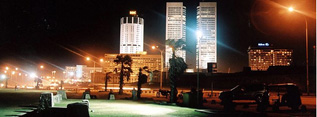
Colombo –
i
s the business and commercial center and the new capital is Sri Jayawardhanapura Kotte, which is only a few miles away.
Colombo was only a small seaport, which came into prominence in the 16th Century with the arrival of the Portuguese in 1505 and the development of it as a major Harbour during the British period and became the capital in 1815 after Kandy was ceded to the British.
The remains of the buildings during the period and the Portuguese, Dutch and British rule are found in every area of the city. None of the Portuguese & Dutch fortifications are found today but some of their buildings and churches could be seen in the Fort & Pettah areas.
Visit Fort, the former British administrative center and military garrison, Sea Street - the Goldsmith’s quarters in the heart of Pettah, the Bazaar area where there is also a Hindu Temple with elaborate stone carvings, the Kaymans Gate with the Belfry at the original gate to enter the Fort, the Dutch Church of Wolfendhaal dating back to 1749, Kelaniya Buddhist Temple, Davatagaha Mosque, Colombo Museum and the Natural History Museum are some of the sites to be visited. Also visit the BMICH (Bandaranaike Memorial International Conference Hall), see the replica of Avukana Buddha and the Independence Square.

Colombo National Museum - Albert Crescent, Colombo 07. Established 1877. Best known for collection of antiques and objects d’art. Over 500,000 publications of Sri Lanka. More than 4,000 palm leaf manuscripts. Among the exhibits are the regalia of the King of Kandy; ancient and medieval jewelry; rare collection of traditional demon masks; wood and ivory carvings; an exquisite collection of Buddhist and Hindu bronzes, specially from Polonnaruwa Period; reproductions of temple frescoes; Chinaware including VOC plates of the Dutch period antique furniture; lacquered objects; stone sculpture and stone inscriptions.
Navam Perahera, Colombo – One of the colorful Buddhist Cultural Pageants held in Sri Lanka annually is the Colombo Nawam Maha Perahera, held in February at the Gangarama Buddhist Temple.
Seating accommodation for large number of persons is provided without charge on three days. The Perahera revives the ancient forms drawing dancing troupes from all parts of the country and providing an occasion to display their dancing skills.
The Perahera was first started in the year 1979
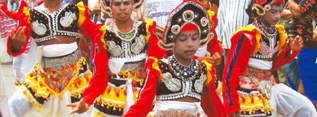
Duruthu Perahera, Kelaniya.
The Duruthu Perahera at Kelaniya is a colorful and exciting pageant held during the month of January.
Duruthu Perahera is held to commemorate the first visit of The Buddha to Sri Lanka in the ninth month of his enlightenment. According to the Sinhala calendar, the visit occurred on Duruthu Poya or the full moon day of the first month to Mahiyangana and The Buddha, accepting an invitation extended by the Naga King Maniakkikha visited Kelaniya. The Buddha preached seated within a gem-studded enclosure or Mandapaya during this visit. The Kelaniya 'Chaitya' is believed to have been built on the spot where this sacred event took place. According to legend, the gem-studded Mandapaya is enshrined in this Chaitya.
King Yatalatissa who reigned in the 3rd century BC is credited with building the city of Kelaniya and the temple while enlarging on the original Chaitya built by King Maniakkikha. Built on a rocky platform in the vicinity of the Kelaniya River, the temple has been destroyed and rebuilt time and again throughout the past centuries. The most recent time, when the temple was destroyed, was in the 16th century during the Kotte period, when the Portuguese invaded the maritime region of Sri Lanka. It was rebuilt in 1767 by Kirthi Sri Rajasinghe, the King of Kandy. The temple was again in a neglected state by the latter part of the 19th century. Improvements to the temple were initiated by Helena Wijewardena, a philanthropist, in 1888 when she commissioned Solius Mendis, the famous temple artist to restore the temple. For over 20 years, Mendis worked in the temple restoring earlier frescoes and adding new paintings depicting incidents from Buddhist history.
It was in 1927 when Helena Wijewardena's son, Don Walter Wijewardena was the Basnayake Nilame and the Venerable Mapitigama Dharmarakkhita Thero was the chief priest of the Kelaniya temple that the Duruthu Perahera was first held. The Perahera takes place on three days in January, the last day being the Full moon Poya day.
The first day, is the Udamaluwa Perahera when the relic casket will be carried three times around the Udamaluwa by the Basnayake Nilames of the temple.
The second day is the Veediya Perahera, when the parade takes place within the precincts of the temple. A representative gathering of drummers and dancers from the temple and the three devales participate in this event.
The third day, is the Duruthu Poya when the Maha Perahera or the main Perahera wends the streets around the Kelaniya temple in all its grandeur.
About 100 elephants are expected to take part in the final Perahera.
Dutch Period Museum, Pettah, Colombo – (closed on Fridays) this building of the 17th Century, has been completely restored by a special Restoration Society with assistance from Netherlands.
The displays depicts the political, social and economic conditions in the maritime provinces of the Island under the Dutch rule and it gives an idea of the culture of the Kandyan Kingdom during the Dutch period.

Kelaniya Raja Maha Vihara Temple – One of the earliest Buddhist Dagobas traditionally believed to be the site visited by the Buddha 2500 years ago. According to the Mahavamsa, the “paddy-heap” shaped dagoba at Kelaniya marks the spot where the Buddha, on the request of a Naga king, sat on a ”gem-studded throne” to preach the Dharma to his subjects and convert them. It is ascribed to King Yatala Tissa of the 3rd Century B.C.
An annual Perahera called “Duruthu Perahera” will be held each year during the month of January for 3 days.
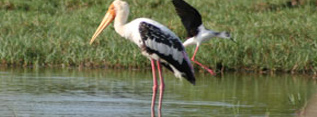
Muthurajawela – is Wetland area of 2,000 hectares between Colombo and Negombo, set aside as a unique tropical wetland, with its flora and fauna of marshes, waters and mangrove forests.
Visitors can set sail on guided boat rides through the different ecological settings of the marsh sanctuary and the lagoon, or walk in nature trails and watch birds.
Some 40% of the vertebrates of Sri Lanka are recorded here.
Plant life is also rich-the marsh vegetation includes mangroves, ferns and many grasses and sedges.
Birds are numerous. Commonly sighted species includes Cormorants, Storks, Bee-eaters,
Kingfishers, Grey Herons, Purple Coots, Little Green Herons, Yellow Bitterns, Black Bitterns, Moorhens and White-breasted Waterhens.
(Contact Phone:- 011-4-830150 or 0777-043447- Aruna).
Galle
| Back to Top |
Galle - Sri Lanka’s most historically interesting town is Galle. It was a major port until about 100 years, but today still handles shipping and sailing boats in the natural harbour.
Stroll around the lighthouse and harbour or visit the old town where you can see the traditional lace makers and wood carvers and purchase some the finest souvenirs.
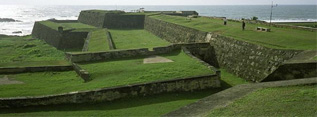
The Dutch Fort - Galle - The South Coast’s major city is Galle, whose oldest landmark is the massive Portuguese and Dutch Fort which is a “World Heritage Site” in which the central city is contained. But the city may be much older. Some scholars believe it to be the “Tarshish” of the Old Testament, to which King Solomon sent his merchant vessels, and to which Jonah fled from the Lord.
Today, the 90-acre Galle Fort shows no evidence of the Portuguese founders. The Dutch incorporated the Portuguese northern wall in a great rampart in 1663. A second, taller wall was built inside of it. Between the two walls, a covered passage connected the central bastion with the Fort’s two half bastion’s overlooking the sea.
The Dutch also installed a sophisticated drainage system, complete with brick-lined underground sewers that were flushed twice a day by the high and low tides. The original gate to the fort was by the harbour. It is still there, marked by the British Coat-of-arms on the front and the Dutch V.O.C. (Vereenigde Oost Indische Compagnie) with the Coat-of-arms with a rooster crest, is on the inner side of the Fort.
Hikkaduwa –
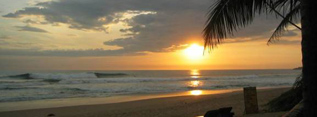
is one of the famous beach resorts in the south coast of the Island.
The beautiful Coral Reef in shallow water, protected by a rock formation is an excellent place for viewing the coral, denizens of fantastically beautiful coral fish swimming among them attract many for snorkeling, divers and tourists interest in viewing them from the comforts of a glass-bottomed boat.
Bright batiks, masks, jewelry and other crafts are sold all along Hikkaduwa’s Galle Road strip.
Surfers find the break at Hikkaduwa to their fancy.
For those who are more adventurous can go for diving to the Black Coral Gardens, beyond the Coral Reef in deep waters, only deep divers could see and admire or they could go for wreck diving to several ship wrecks close to Hikkaduwa.
Several hotels are providing facilities for Deep Sea fishing trips and there are several Diving Schools with “PADI” Dive Masters conducting classes.

Ambalangoda - It is a charming town, most famous for its “devil-dancers” and mask carvers. You will be fortunate to encounter an actual bali (exorcist) or kolam (folk drama) performance, as these are not performed especially for visitors. On the other hand, if you do manage to attend a ceremony, you can be assured that it is the real thing.
The masks of bright colours are created based on the “authentic” masks used for curing patients suffering from 18 types of ailments they suffer.
Beruwela - on the South coast of Sri Lanka lies the city of Beruwela.. Many interesting sightseeing tours are possible from here, such as the Turtle Hatchery, Mask factory, Galle Fort, Mini Zoo, Garden brief, Lunuganga, This is one of good beach resorts of the south coast with many hotels providing facilities for tourists.
Beruwela and Bentota are the best areas for water sports such as water Scooter rides, wind surfing. para-sailing, water skiing, and river cruising. Beruwela has necessary facilities for Deep-sea Fishing and Wreck & Coral Reef Diving.
Bentota – is the first National Holiday Resort developed by the Ceylon Tourist Board as a planned resort. There are 6 tourist hotels in the beach span of 5 miles with all the facilities a resort would require.
Water sports facilities are available as in the Beruwela Resort.
Many interesting sightseeing tours are possible from here, such as the Turtle Hatchery, Mask factory, Galle Fort, Mini Zoo, Garden brief, Boat trips on Bentota River etc
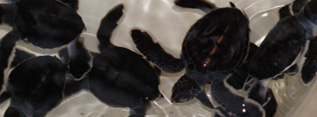 .
.
Kosgoda Turtle Hatchery - Where you can see five species of turtles-Green Turtles (Chelonia mydas), Hawksbill Turtle (Eretmochelys imbricata), Loggerhead Turtle (Caretta caretta), Leatherback Turtle (Dermochelys coriacea) and Olive Ridley Turtle (Lepidochelys olivacea).
The eggs collected by the Villagers and Fishermen are purchased by the Kosgoda Hatchery and kept in sandy pens until they are hatched. The newly hatched ones are kept in tanks and released to the sea in the night. This Hatchery alone has released more then 1,750,000 young turtles to the sea. An endowment by the Hasselblad Estate was responsible for the establishment of this hatchery.
Wadduwa - is located 22 miles from Colombo, approximately 01 hour’s drive by car? It is a small fishing village. Wadduwa is famous for toddy tapping. You will be able to see Tappers walking on ropes tied from tree to tree. The town is also famous for coir works, rugs, brooms, carpets, etc. A short distance away is the Kalutara town, which is famous for the beautiful Dagoba and the sacred Bo Tree. The river (Kalu) is good for water sports activities and famous for river safaris. There is a beautiful Buddhist temple in Wadduwa.

Kalutara - The Gangatilaka Vihara at Kalutara can be seen from miles away. This huge new dagoba, just south of the Kalu Ganga Bridge, marks the site of an ancient Buddhist temple. The outer dome is hollow and a small dagoba is found inside with a beautifully painted interior.
The Bo Tree in front is a famous place with motorists who stop their vehicles to put a coin to the tilts kept out near the road to ensure the safety and success of their journeys.
Hambantota
| Back to Top |

Hambantota - the largest town on the southeastern coast with a population of about 20,000, is a well-sheltered fishing port. Its lovely Rest House hangs on reddish cliffs, which overlooks a white beach backed by sage-green jungle. Just outside the town are saltpans where seawater is left to evaporate, then carried by rail to salt factories.
Close to the Rest House is the “Martel Tower” of the Dutch of which the only other example is found in France. Is used now as a Marine Museum and from the rood of the upper floor you can get a “Gunner’s view” of the ships passing on the shipping lane.
The Salt-terns Maha-Lewaya and Koholankala Lewaya are famous for Birds as well specially for a large flock of Lessor Flamingos.
Turtle Hatchery –Rekawa, Tangalle – is one of Hatcheries where the eggs are left at the nests on the beach, well protected from predators and people until they are hatched and allow the young ones to go to the sea in the natural way.
This is a place you can see the Turtles when they come ashore, lay their eggs, close the nests and goes back to the sea.
Here you can see the 5 species of Turtles coming to our beaches to lay their eggs.
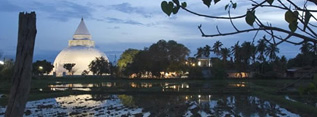
Tissamaharamaya - The ancient capital of the province of Ruhuna, to which Sinhalese patriots rallying support against Indian invaders fled. No systematic excavation of the known (and unknown) archaeological sites of Ruhuna has yet been undertaken.
The exposed monuments consists of Menik, Yatala, Tissamaharama and Sandagiriya Dagobas and the large pillared hall close to Yatala Dagoba supposed to be the Temple where the Sacred For-head Relics of the Buddha was kept until it was enshrined at the Tissamaharama Dagoba.

Kataragama – in the deep south of the country is a shrine dedicated to God Skanda (Murugan) the God of Love and War and is believed as a Devala started in the 2nd
Century B.C. by King Dutugemunu (167 –137 B.C.).
Today Kataragama is a place of worship for Buddhists, Hindus and some Muslims.
This is a very popular place of pilgrimage for south Indian Hindus as Kataragama God came from India, married a Jungle Girl and lived here. When his Indian wife came in search of him he refused to go back. All of them lived here happily.
There are separate shrines for the two wives Tevani Amman Kovil for the Indian wife and Valli Amman Kovil for the Sri Lankan wife.
During the month of July a 10 day festival is held here with the Perahera, Fire walking, hanging on hooks and other penance’s.
The best time to be in the Devala is at the time of the Pooja (Offerings) to see the rituals and the Virgin Dancing girls offering light and dancing in the Devala.
Bundala National Park – an area of 6216 hectares is Sri Lanka’s only “RAMSAR”
Wetland that hosts over 20,000 shorebirds, during the period August to April.
The Park consists of lagoons and inter-tidal mud flats where wintering birds rest and feed, golden sandy beaches and sand dunes where sea turtles nest and the thorny scrub-land where elephant, spotted deer, wild buffalo, wild boar, crocodiles and peacocks roam.
More than 150 species (including 45 species of ”Waders”) of resident and migrant birds could be seen in this Park.
Thousands of Greater / Lessor Flamingoes, Spot-billed Pelicans, Spoonbills, Ducks, Indian Shags, Cormorants, Stone Plover and various species of Herons.
Pathirajawela, within the Bundala National Park, is a site where the earliest evidence
of the pre-historic man is found in the Island.
Sithulpahuwa Vihara - Sithulpahuwa Vihare is situated inside the Yala National Park, 18 miles from Tissamaharamaya and about 10 miles east of Kataragama.
This is Monastery Complex spread in a large area with remains of 10 Dagobas on 10 hills around, more than 65 caves with 3rd – 2nd Century B.C. inscriptions where thousand of Buddhist Bhikkhus had done their meditation practices and a large cave with a recently done Buddha Statue. Many ruins of buildings are found in the jungle and 2 Dagobas are now renovated.

Yala (Ruhuna) National Park- the Ruhunu National Park covers 126,786 hectares
Including the Strict Natural Reserve (Block II). The most familiar is Block I (14,101 hectares) and this block was established in 1938.
Yala is famous for its big herds and large number of Elephants, Leopards, Spotted Deer, Sambhur, Crocodiles, Mongoose, Wild Boar, Wild Buffalo, and many other animals.
More than 130 bird species are recorded which includes the resident and winter visitors.
There are 7 Bungalows inside the Park with few Camp Sites.
Monaragala
| Back to Top |

Lahugala-Kitulana National Park – is 192 miles from Colombo on the Colombo, Wellawaya, Moneragala and Siyabalanduwa Road. There are 3 tanks ( Lahugala, Kitulana and Sengamuwa) within the National Park and all of them are covered with Beru (Opilismanus Compositus) grass favorite among Elephants. Lahugala is connected to Yala East National Park and Galoya National Park and is in an elephant corridor.
The main tank Lahugala (also called Mahawewa) is by the side of the main road at 191-mile post is the elephant crossing to the tank, which is 600 acres in extent.
Bird life is also plenty in the tanks and the jungle-specially the birds of prey.
Other animals including Spotted Deer, Wild Boar Sambhur and Leopards and Sloth Bear could also be seen.
2 miles away is the famous temple Magul Maha Vihara connected with King Kavantissa where there is a unique Moonstone and other ruins.
Maligawila – is close to Buttala in the Southern Province where there is a Buddha Statue, carved out of a limestone 34 feet in height, 10 feet across at the shoulders, a rare statue carved in the round from a single stone and raised here on a lotus pedestal. It had fallen down for a very long period and was raised recently. The Statue is dated to7th Century, in a monastery complex identified as the old Ariyakara Vihara, according to an inscription at the site.
About 300 yards away at the same site is another beautiful statue 25 feet in height
identified as a Mahayana Statue called Dambegoda Avalokitesvara Bodhisattava Statue. This may dates to circa 8th Century.
Buduruvagala Statues - at Buduruvagala 2 miles from the Nugeyaya Junction on the Wirawila - Wellawaya road is a group of Mahayana figures sculptured on the face of a rock. The central figure is a Buddha statue in the Abhaya Mudra, 51 feet high, flanked on each side by 3 Bodhisatva figures including the Female Tara figure.
To the left of the Buddha are the figures of Avalokitesvara in the center, Bodhisattva Sudanakumara on to the left and Tara on the right of Natha.
The other 3 figures consist of Maitreya Bodhisattva in the center and Vajrapani or Vajrasattava to the right and Padmapani or Manipadma Bodhisattava to the left.
The figures are in high relief and had earlier been finished with stucco. The figures are dated to 8th century A.D.
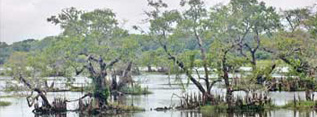
Yala East (Kumana) National Park – is 70 square miles (18,149 hectares) in extent and was declared in 1970. There are several marshes and lakes where large number of aquatic birds built their nests and visitors can see them at close range during the breeding season.
The approach is from the Pottuvil side and it is also possible to visit Kumana from Yala (Ruhuna) Park through Block II which is a Strict Natural Reserve for which entry is allowed only with a special written approval.
The common birds found here are Spot-billed Pelicans, Cormorants, Egrets, Spoonbills, Herons, Storks, Ibises, Bitterns, Indian MoorHens, White-breasted Waterhen, Painted Storks and many other species.

Diyaluma fall - the 680-foot high waterfalls of the Poonagala Oya is close to the road between Koslanda and Wellawaya. It is the last of a series of waterfalls of this stream. The Diyaluma Falls is the World 6th highest.
Above this big fall are several smaller ones to be visited after climbing a steep path to the ridge where the waters flows down. The Poonagala Oya rises from the Mahakande pass. She flows into Kuda Oya, a tributary of the Kirindi Oya.

Ravana Falls - a nice waterfalls of 1080 feet high close to the road from Ella to Wellawaya about 6 Km south from Ella. The stream, a tributary of Kirindi Oya plunges with a foaming spray over a series of ledges into the valley close to a road bend. The waters rise from Wewatenna highland above the rocks. In general the rocky underground of the waterfalls in Sri Lanka consists of hard gneiss or granite, but here the material is khondalite, a kind of limestone which undergoes decay faster. Thus there are caves near the falls. King Ravana of Ramayana legend is said to have lived in one of the caves above the waterfalls.
| Back to Top |
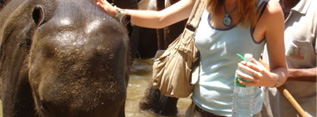
Pinnawela Elephant Orphanage - App. 55 miles from Colombo, off the Colombo - Kandy road is Pinnawela, where an orphanage was started in 1975 to house the abandoned and the wounded elephants. The number of elephants has increased to more than 65 now; including Baby Elephants brought from various parts, as well as the 23 babies born, as a result of the captive breeding programme. The best time to visit is the feeding time from 0930-1000 hrs and 1330-1400 hrs and the bathing time from 1000-1030 hrs and 1400-1430 hrs when all the elephants are taken to the river close by.

Kandy – the hill capital is another “World Heritage Sites”. It was the last stronghold of the Sinhalese Kings during the Portuguese, Dutch and British rule and finally ceded to the British in 1815 after an agreement.
To the Buddhist of Sri Lanka and the World, Kandy is one of the most sacred sites as it is the home of the “Dalada Maligawa” - Temple of the Sacred Tooth Relic of Lord Buddha.
Close by are the remains of the Royal Palace (Maha Wasala), Palle Wasala- where the Queens stayed-now used for the National Museum, Meda Wasala where other close relatives lived, Audience Hall, Natha Devala and Vishnu Devala are situated. The Bathing Pavilion (Ulpenge) is by the Lake and in the Center of the lake is the Island called “Kiri samudraya” (Milk white ocean) used by the kings as the summerhouse.
Today it is the center of Buddhism, Arts, Crafts, Dancing, Music and Culture.
Visitors can see these Dance & Music at the daily Cultural Performances held at several places in the city.
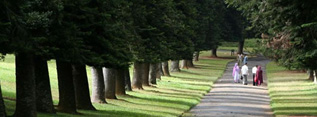
Royal Botanical Gardens - Peradeniya - 147 acres in extent; Started in 1374 as a pleasure garden of the Kings of Gampola and Kandy. There are more than 5,000 species of trees, plants and creepers. Some rare and endemic as well as flora from the tropical world are found in the gardens. Spice Garden and Orchid House are popular with tourists.
There are 5 Palm Avenues beautifying the gardens, the earliest and tallest Palm Avenue (Royal Palm Avenue) was planted in 1905 and the Double Coconuts from the Seashells Island, with the largest seed of all plants in the world is one such avenue.
Padeniya Temple – The original Temple at the site may dates to 3rd C.B.C.and according to legend Theraputhathbhya, a Paladin of Dutugemunu (161 - 137 B.C.) had became a Buddhist monk and lived here. Most of the present monuments dates to the early Kandy period.
This Temple has wooden pillars in the shrine room with wood carvings of wrestlers, animals, female figures and various other designs similar to Embekke Devala is found here. The unique feature here is the raised plinth, filled with sand leveled for writing the letters of the script for teaching the students. Four large octagonal stone pillars from 04 ancient dagobas are found at the site.
Access just after the 62nd milepost on the A10 from Kurunegala to Puttalam, where A 28 starts. The Temple is by the side of the junction
Udawattekele Sanctuary – In 1856 Udawattakele or “Udawasalawatte” was declared as a Protected Forest and declared as a Sanctuary in 1938.
It is 257 acres in extent and the approach road is from the town near the Municipal Council Office of Kandy.
There are 33 different species of Trees, 23 species of birds (07 endemic), 06 Mammals (01 endemic),
The Garrison Cemetery of Kandy is within the Sanctuary behind the Temple of the Sacred Tooth Relic, where 163 graves of British Nationals are found.
The entrance fee is Rs. 250/- per person.
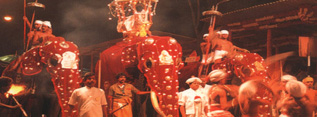
Kandy Esala Perahera –
The Kandy Esala Perahera is an annual event that is held during the mid-summer nights during the months of July / August every year for 10 days ending with the day perahera with the Water-cutting ceremony held at Getembe near Peradeniya.
This gorgeous cultural pageant has history, religion and a nation's culture mingled in it. This traditional rehearsal of Kandy's past glory carries a spiritual message too and it also shows the harmonious blending of Buddhism and Hinduism.
For a long time a traditional procession was held in honour of the four Hindu Gods, Natha, Vishnu, Skanda and Pattini and during the reign of King Kirti Sri Rajasinghe
the Temple of the Sacred Tooth Relic was also added and prominence was given to it by leading the Devala processions.
This colourful Kandy Perahera consists of a Kap Planting Ceremony (planting the holy stick), followed by 5 days of Kumbal Perahera increasing the splendor by changing the distance and routes, increasing the number of Dancers, Drummers, Elephants everyday and succeeded by the Randoli Perahera which will increase its splendor daily and on the last 3 day more than 100 elephants will take part in the procession.
On the last day the Perahera will be held during the Day ending up with the visit to Getembe near Peradeniya where Water Cutting Ceremony will take place.
The chiefs in silver and gold ceremonial dress with world famed Kandyan dancers and drummers are notable attractions. However, the highlight of the procession is the richly caparisoned Maligawa Tusker. During the perahera set against the background of a starry tropic night, the ancient city of Kandy echoes and re-echoes, as it certainly did centuries ago, to the tunes of massed drums and flutes, the cracking of whips and the clang of elephants' bells while the solemn cheers of worship from the enthusiastic spectators are enchanting indeed.
The Randoli Perahera -
For the first five nights, this possession is known as Kumbal Perahera; it shows only a shadow of its climactic splendor. But on the sixth night, the Randoli Perahera begins. The randolis (“golden palanquins”) which bear the deities’ consorts join the devala ranks, each bore immediately behind the elephants carrying the emblems which represent the respective deities. The circuits gradually increase in length and the trappings in grandeur, until after five nights of the Randoli, the Perahera reaches its magnificent and colourful best. This climactic Randoli Perahera may include 100 or more elephants, ranging from majestic bulls to half grown calves.
Tea Plantation - Tea was first planted in Sri Lanka in 1824 at the Botanical Gardens at Peradeniya, when a few plants were brought from China. More were introduced from Assam in 1839.
In 1867, a Scottish Planter named James Taylor planted tea seedlings in an 8 hectares of forest land, in the Loolkondura Estate.
In 1873, the tea export industry of Sri Lanka began with a modest 23 lbs. being shipped to London.
Tea will grow only on rolling terrain and is classified by elevation into low grown, medium grown and high grown into 3 main groups. Today more than 200,000 hectares in highlands and other areas are under Tea and around 300 million Kilograms, with a 25% of world tea exports are done by Sri Lanka as the World’s largest Tea exporter.
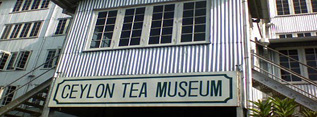
Ceylon Tea Museum – is located at Hantane, 3 miles from Kandy in the Hantana Estate.
The museum exhibit memorabilia machinery, documents, books, pictures and objects of historical value to the tea industry.
Some of the exhibits consists of a hand operated tea roller over 100 years old, the first tea drier ever made called Venetian Drier, 56 years old packet of Tea still in the original packing, items belonging to James Taylor and many other items.
The Museum is closed on Poya days and Mondays and is opened on other days from 0815 to 1645 hours only.
Wasgamuwa National Park – was declared in 1984 for Bio-diversity conservation. Wasgamuwa is only 145 (225 km) miles from Colombo via Kandy. The Park comprises of 39,322 hectares.
Around 150 – 250 Elephants are found in the Park, Wild Buffalo, Spotted Deer, Wild Boar, Sambhur, Crocodiles, Leopard, Sloth Bear and other animals of the 23 species of Mammals recorded.
143 species of birds (8 endemic), 17 species of reptiles (5 endemic), 17 species of Fishes (2 endemic), 50 species of Butterflies (9 endemic) are recorded from Wasgomuwa National Park.
There are 3 Bungalows within the Park, 2 outside and 7 Camp sites at the Wasgomuwa National Park.
| Back to Top |

Ratnapura - literally means ‘city of gems’ and is set like a gem itself in a panorama of glorious scenery. You will see the world famous Ceylon Sapphires being mined.
Most of the miners still rely on ‘Lady Luck’ to guide them through their digging, sifting washing and sorting of the stones. In the Private Gem Museums collection from all over the world can be seen alongside collections of all Gem stones found in Sri Lanka and some pre-historic relics collected from the gem pits of the Ratnapura district.
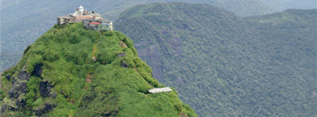
Adam’s Peak – This is most sacred mountain in Sri Lanka sacred to all four major religions-Buddhism, Hinduism, Muslims and Christians. Buddhists call the mountain Sri Pada (“the sacred footprint”) and say it was visited by Gautama Buddha and placed His Footprint on top of the mountain. To Hindus, the peak Shiva Adipatham has the Shiva’s footprint. Muslims insist it is the place where Adam first set foot on earth when he was expelled from the Garden of Eden. And Roman Catholics say the footprint impressed in the boulder at the summit is that of St. Thomas, the early Christian apostle who preached in South India. People of all religious groups ascend the mountain on pilgrimage from the Full moon Poya day in December till the Full Moon Poya Day in May when the pathway to the summit is lighted in the night and other facilities are provided.
Saman Devalaya – at Ratnapura is dedicated to the Deity Saman, the God of Adam’s Peak. The Devala is about two miles outside Ratnapura town on the Kiriella road.
The Devala was built by King Parakramabahu II who ruled at Dambadeniya in the 13th Century. It reached the height of its glory during the Kotte period two centuries later. The Portuguese destroyed it in the 1620s; ironically, the Devala was restored in late Dutch time.
The annual Perahera is held for 3 days during the month of August / September after the Kataragama Perahera and many Elephants, Dancers & Drummers and others take part. Special dance forms of Sabaragamuwa could be seen in this Perahera.
The most interesting item is the last item of Water Cutting Ceremony in which boats will take the entire Perahera, minus the Elephants to the place selected down stream of the river for the Ceremony.
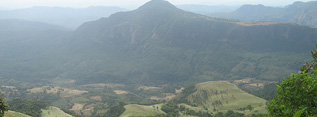
Sinharaja Rain Forest Reserve - Sinharaja is the only ”World Heritage Site” Rain Forest in Sri Lanka, with a very high rate of bio-diversity. The vegetation is tropical wet evergreen forest and the area under the reserve is 11,187 hectares.
Out of the 331 woody trees and lianas identified 192 (60%) are endemic at Sinharaja.
Regarding Fauna 141 bird species recorded here and 24 are endemic (27 for the entire country), Butterflies 65 species (1 endemic), Fishes 10 (07 endemic), Amphibians 19 (08 endemic), Reptiles & Snakes 29 (14 endemic), and Mammals 40 (07 endemic).
Sinharaja is the only relatively undisturbed rain forest of any considerable size and many of the plants are very rare and are represented by only one individual of its kind in a large area.
Sinharaja can be reached from Colombo via Matugama (174 km) or Ratnapura (154 km)
to Kalawana, Weddagala and up to Kudawa Base Camp. From Galle to Deniyaya and Mederpitiya (10 km) and from there to Pitadeniya Camp and enter the Reserve.
The best period to visit is between December to early April and from August to September.
Maduwanwala Walauwa – At Kolonna in the Ratnapura District on the Embilipitiya –Suriyakanda road. The first Walauwa at the site was constructed by Maduwanwala Maha Mohattala in 17th Century during the period of King Wimaladharmasuriya II (1687 – 1707) and for sending a White Sambhur to the Palace as a present to the King, 84,000 acres of land was given as a gift (Nindagama) in Kolonna Korale.
The present Walauwa was constructed by Sir James William Maduwanwala Maha Dissawa ((1877- 1905) and consisted of 121 room, 21 Center courtyards (Meda Midula) and a “Sie Meduru Kavuluwa” (a room with views to all directions).
What are left today are 21 rooms, 4 Center Courtyards and the room with he view of 4 directions.
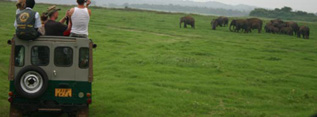
Uda Walawe National Park - with an area of 30,821 hectares covers the catchment area of Uda Walawe reservoir. With boundaries running into Ratnapura and Monaragala districts at the SouthEastern Part of Sri Lanka. Haputale and Kaltota mountain ranges, seen from the park give a picturesque view. It provides a home for displaced animals from Walawe Development Project.
Rich in elephant population the park is having an estimated 500 or more elephants. They roam about in herds of 50-100 at times. The park is known to be a good breeding ground, for Baby elephants, guarded by their elders are seen round the year.
To see elephants in their natural habitat visitors are advised to travel in Jungle Green vehicles and similar coloured clothes. Elephants quickly spot (White and bright colours).
| Back to Top |

Aluvihara Temple is situated just north of Matale, about 18 miles from Kandy. Here, in 2nd century B.C., the Buddhist scriptures (the Tripitaka) were first committed to writing in “Ola leaves”, a chore that required the devout attention of about 500 senior monks 2,000 years ago. The rock caves were formed long ago by boulders tumbling down a nearby mountain. They contain various icons and frescoes. One cavern graphically depicts sinners’ hell.
Few years ago these books were written down once again and this is one of the few places where visitors can see the method of preparing the Ola leaves as pages of books and the method of writing on them.
Dambulla - is a vast isolated rock mass 500 feet high and a mile around the base. Here is found the famous Rock Temple dating to the First Century B.C. The caves of Dambulla sheltered King Walagamba during his 14 years of exile from Anuradhapura. When he regained the throne he built the most magnificent of Rock Temples to be found in the Island.
In the first Cave is a recumbent image of the Buddha 47ft long cut out of the Rock. There are images of deities associated with Buddhism all around. The frescoes on the walls and the ceiling are the oldest here but they are over painted in the Kandy period.
In the Second Cave, the finest and the largest of all, there are 150 life-size statues of the Buddha in various postures with few statues of Gods and Kings. The ceiling is also covered with frescoes, which depict great events in the life of the Buddha and landmarks in the history of the Sinhalese people.
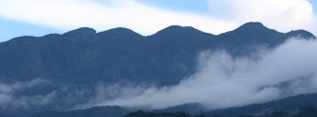
Knuckles Range Forest Reserve – is 90 square miles in extent (land above 3500 feet only) and the area within the mountain range extending for a distance of more then 12 miles covers about 28,000 hectares?
This range is in the Kandy District on the Kandy-Mahiyangana road.
This range gets rain during both monsoons- Northeast and Southwest.
35 mountain peaks in the range are above 3,000 feet and the 2 highest peaks are above 6,000.
More than 100 species of birds are found and out of them 20 are endemic, 28 Fishes-9 endemic and 3 species of them are found only in the Knuckles Range and large number of trees are endemic.
The approach to the range is from several areas and the easiest is through Hunasgiriya, Looluwatte and Corbet's Gap and from there to Kaikawala or Meemure or Na-ela and trekking from there.
Nalanda Gedige- at Nalanda on the Dambulla Kandy road few miles from the road is the Gedige monument a stone building dating from the 8th Century and one of the most remarkable examples of the amalgamation of Hindu and Buddhist architecture. This is a Buddhist Temple and the shrine room has a “Gopuram” like structure above the shrine room but the figures and statues are Buddhist. This may be a Mahayana shrine, with its stones containing rare “Tantric” carving of a sexual theme in one sculpture.
Spice Gardens at Matale – You will see many spice gardens at Matale and in Mawanella on the Colombo-Kandy road where Cinnamon, Cardamom, Pepper Creepers and all other spice trees, plants and creepers are planted for visitors to see them. Spice products are also available for those who would like to buy them. At all Spice Gardens visitors are taken round explaining each tree and plant and at the end explaining the use of them food preparations.
Afterwards visit a Batik Factory where you can see the manufacture of beautiful Batik prints. These shops contain a wide variety of Batik items.
Kurunegala
| Back to Top |
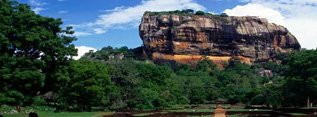
Sigiriya – is a “World Heritage Site” and the 5th Century “Fortress in the Sky” which is perhaps the most fantastic single wonder of the Island. It is also known as Lion Rock because of the huge lion that used to stand at the entrance to the Palace on the summit of the 600-foot high rock. On its summit are the foundations of the Royal Palace, Water Tanks to supply water and all other buildings and at the edges the guardhouses. On one of the stairways the only known ancient work of Sinhala secular painting survived in the form of Frescoes of 21 life sized damsels in all the freshness and delicacy of their original colour.
The Water Gardens, Fountain Garden, summerhouse, Boulder Gardens and the Caves with the enclosed are should not be missed.
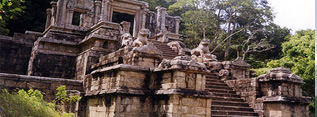
Yapahuwa – is a rock fortress turned into the Capital of Sri Lanka in the 13th Century
By King Bhuvanekabahu I (1272 – 1284 A.D.). Unlike Sigiriya, the palace was not built at the summit of the 300-foot rock, but, instead, two semi-circular walls, two moats and a Mud moat, protected the royal palace complex.
The stone staircase, reminiscent of Cambodian style, is among the handsomest on the island. Friezes of jubilant musicians, dancers and drummers decorate the last staircase and the porch above them.
Also see the small museum with more than 500 Chinese coins and pottery, a beautiful stone window-the best available in the country, old paintings in the cave temple, remains of the Tooth Relic Temple and other ruins.
To reach Yapahuwa, travel south from Anuradhapura on Route B63. 40 miles (64 km) to Maho turn east and look for the massive rock to the south.
Trincomalee
| Back to Top |
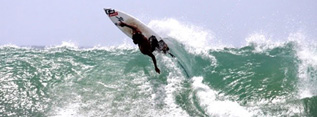
Trincomalee - 165 miles from Colombo, is one of the largest and safest Natural Harbours in the World. Trincomalee is connected by Rail and Road. It has sunny weather throughout the year, with white sandy beaches, calm, placid and warm waters, ideal for underwater activities and for Whale watching.
Trincomalee was a Buddhist Center known as “Gokanna” from very early times and later a Hindu Kovil was constructed at the site.
In 1617 five (5) Danish ships entered Koddiyar Bay, but the negotiations with the Kandyan King was fruitless and they sailed away.
In 1624 the Portuguese completed the construction of a Fort here after destroying the Hindu Temple at Swami Rock in the Fort.
The Fort, which had only 3 Bastions was taken by the Dutch in 1639, but abandoned, re-fortified in 1675 and named it Fort Fedrick.
In 1795the British captured it after a 4-day bombardment and it became the first possession of the British in Sri Lanka.
Nilaveli-10 miles away is the finest beach in Trincomalee starting at Uppuveli- 5 miles away extending all the way to Nilaveli. Pigeon Island is a great place for Diving, Snorkeling and sea bathing.
Velgam Vehera – 6 miles away near Periyakulam Tank is the Temple known to Hindus as Natanar Kovil dating from the 2nd C.A.D. After the Chola Invasion Hindu contributions helped restore it as a Buddhist Temple.
There are 7 Hot Spring at Kanniyai just 5 miles away on the Anuradhapura road.
Thiriyai Vata-da-ge is 30 miles to the North of Trincomalee and is one of the best monuments in Sri Lanka.
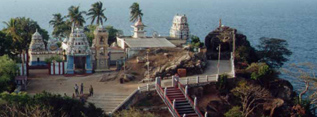
Koneswaram Temple - According to an inscription found on the doorway to the Fortress this Temple was constructed by King Kulokoddan in 3rd Kaliyugaya, with 1000 columns. Destroyed by the Portuguese in the 16 Century A.D. they threw all the columns down to the sea below.
Three bronze statues were brought up by divers found among the columns in the sea and are now kept in the modern temple at the same site, within the Dutch Fort in Trincomalee.
Jaffna
| Back to Top |

Jaffna – is 246 miles from Colombo and can reach by Air or Road. The Rail connection is now only up to Vavuniya.
The Jaffna peninsula has an area of 380 square miles.
Jaffna was important for both Portuguese and Dutch. Jaffna Fort was completed in 1632 and it covers 55acres in extent. The Dutch Church inside the Fort dates to 1706.
There are ruins of Portuguese Churches at Myliddi and Chankanai and a ruined Dutch Church at Atchuveli. The Dutch Fort Hammenhiel is at the entrance to the Kayts Harbour and is delightful.
Jaffna is full of Hindu Kovils. The Nallur Kandasamy Kovil and Vallipuram Kovil at Point Pedro are two of the important Kovils.
The Buddhist Vihara at Nagadeepa (Nainativu ) Island is a place sanctified by the visit of the Buddha and the dagoba is an old one.
The large number of dagobas in the Kantharodai site dates from 2nd to 10th Centuries A.D.
At Keeramalai is a freshwater bathing pond on the beach and is said to possess therapeutic properties.
Badulla
| Back to Top |
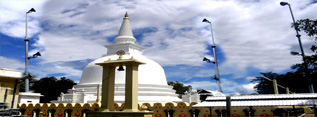
Mahiyangana - One of the earliest Buddhist sites, sanctified by the visit of the Buddha to settle a dispute among two clans of people living here. It is mentioned that he had levitated at once terrifying the people and he had expelled the Yakshas of one clan to a site called Nagadeepa-identified at Nainativu Island in Jaffna and settled the dispute.
A Dagoba was erected at the site enshrining the Sacred locks of the Buddha’s hair.
This Dagoba was conserved recently and the Archaeologists who excavated the ruined monument opened up the Relic Chamber inside and found fallen plaster containing paintings and were able to get 4 paintings after fixing the pieces together.
They are now in the Kandy Museum.
Few miles away are the two settlements of Veddhas-the aborigines of Sri Lanka. They are living at Dambana-15 miles away and Hennanegala- 25 miles away, near the entrance to Maduruoya National Park.

Ella - 127 miles from Colombo and 8 miles from Bandarawela, on the leeward side of the central mountains. The view from Ella Gap is one of the most spectacular scenic sights in Sri Lanka - the landscape falls away in a dizzy drop of 3000ft to the eastern plains.
The Ella rock is famous for the cave of Ravana a legendary king of Sri Lanka ruled during the pre-historic times. The 1080 foot high waterfall few miles from the Ella Rest
House is one of the most beautiful falls in the country.

Gal-oya National Park- is 230 miles on the Colombo, Kandy, Mahiyangana, Mahaoya and Ampara road, which is the shortest out of the 3 routes. This National Park declared in 1954 is 25,900 hectares in extent and covers most of the catchment area of the Senanayake Samudra.
The areas to visit by Jeep are limited from Ali-wanguwa to Kossapola and from Mullegama to Kebellabokka. The main method of travel is by boat from the Bund of the reservoir to observe wild animals and birds in the open areas along the lake.
Permits and Trackers could be obtained from the Wild Life Office at Inginiyagala close to the Lake. (Check the availability of the boat before sending tourists).
Wild Elephants, Wild Buffalo, Wild Boar, Spotted Deer, Barking Deer, Sambhur, are the main animals. Leopard and Sloth Bear are rare and difficult to see.
Many species of birds, specially nesting birds on the dead trees in the water could be seen.
Nuwara Eliya
| Back to Top |

Nuwara Eliya - The ‘Little England’ of Sri Lanka, is set against beautiful backdrops of Mountains, Valleys, Waterfalls and Tea Plantations. It is supposed to be one of the coolest places in the Island, but it is really just like an English spring day, although the temperature does drop at night. All around Nuwara Eliya you will see evidence of the British influence, houses like country cottages or Queen Ann style mansions.
The Victoria Park, in the middle of the town, is a lovely place for a stroll or a picnic and is also good for Birding as you get some rare birds in this Park.
Seasons may be absent elsewhere in Sri Lanka, but here you can read them by the flowers, which bloom in the spring (march to May) and the fall (August and September). These are the “seasons” when low-country folk flock to Nuwara Eliya to escape the sea level heat and humidity.
World’s End - is at Horton Plains 20 miles from Nuwara Eliya. Horton Plains is the Sri Lanka’s highest plateau at an elevation of 7,200 ft. the central mountains.
An early morning departure by jeep to visit the Worlds End before 10.00am (mist obscure the view thereafter) is recommended. This incredible view at the site aptly named “World’s End” is considered to be the finest in all Sri Lanka. The terrific escarpment drops vertically for about 1,000ft and falls away almost as steeply for another 4,000ft. In the morning a crescent of silver of the Indian Ocean rims the horizon some 50 miles to the south.
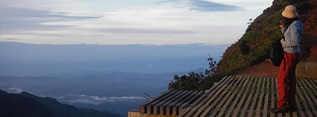
Horton Plains National Park – 20 miles (32 km) from Nuwara Eliya via Ambewela and Pattipola, is the Horton Plains only 3160 hectares in extent. Known to Sri Lankans as Mahaeliya, it became Horton Plains after Sir Robert Horton, British Governor from 1831- 1837.
Horton Plains became a Nature Reserve in 1969 and upgraded as a National Park in 1988 due to its unique watershed and bio-diversity values.
Its flora has high level of endemism. The hills are covered with diverse wet low evergreen forest with even large trees grown flattened to the ground on the higher windswept slopes.
Horton Plains harbours 52 species of resident birds and 11 species of migrant birds.
More then 2,000 to 3,000 Sambhur, Bear Monkey, Leopard, Barking Deer, Giant Squirrel, Fishing Cat, Wild Boar and Hares roam in the forests and grasslands but only seldom they could be seen other than the Sambhur in the evening and morning.
For accommodation Ginihiriya Bungalow (Anderson Lodge) with 4 DBL rooms and 2 separate dormitories (Vana Nivahana) serve for groups.
Two escarpments- “World’s End” and “Little World’s End” falling from the Horton Plains 1000 feet and 3000 feet respectively, to the land below and the Baker’s Falls are places you should visit.
This is the only Park where visitors could walk on their own on the designated tracks.
Sita Amman Kovil, Nuwara Eliya.
According to the Indian Epic Ramayanaya legend, the area where Sita, Queen of King Rama was kept in hiding and the area she roamed is in the hill country of Sri Lanka.
In Nuwara Eliya is the "Sita Amman Kovil" - a quaint little temple, with the statues of Rama, Sita, Hanuman, Lakshmana and Sugriva.
This is supposed to be the only Kovil in the entire World dedicated to Sita. The stream by the side of the Temple is a famous spot where she went for bathing.
Out of the 13 Palaces of Ravana, two caves in the Strict Nature Reserve of Hakgala, starting from Temple land and the cave at Ella close to the waterfall "Ravana-Ella" (1080ft. high) where Ravana went for bathing, are supposed to be three Palaces Sita was kept in hiding.
The Hakgala Gardens may be the "Ashok Vanaya" of Ramayana where Rhododendrons in full bloom are found throughout the year.

Hakgala Botanical Gardens - Four miles south east of Nuwara Eliya is another prominent peak, Hakgala. At its foot lie the Hakgala Botanical Gardens, and above it is the Hakgala Strict Nature Reserve. The gardens 55 acres in extent is smaller and less exotic than the Peradeniya Royal Botanical Gardens, but at 5,600 feet (1,707 meters) elevation the species of flora are quite different. Opened as an experimental Cinchona plantation for the production of the malaria antidote quinine in 1860, the pride of the gardens is now roses and tree ferns.
Gampaha
| Back to Top |

Negombo - a famous fishing village North of Colombo, with a Dutch built Canal. The canal itself is a hive of activity with fishermen traveling up and down in their gaily-painted boats. On the shores of the canal you will find many homes and churches and many species of birds including spectacular Kingfishers.
Catamaran trips in the sea and boat trips in canal can be organized. From November to April, diving facilities are available in this quaint village. The streets on either side of the Hotels are dotted with Souvenir Shops, Restaurants etc.
Puttalam
| Back to Top |

Munneswaram Temple: This Temple in Chilaw is 50 miles north of Colombo. One of the most holiest Hindu Temples in Sri Lanka, coming down from the period before Ravana. Even King Ravana used to pay homage to this temple.
The annual festival is held in July/August, where fire walking can also be witnessed.

Wilpattu National Park – is 508 square miles (131.694 hectares) in extent and was declared as a National Park in 1938.
The special feature in this Park is the large number of Villus (lakes) where you can watch wild life and many species of birds.
Leopards were the most famous animal in this Park and are famous for its Wild Elephant herds. Spotted Deer, Sambhur, Barking Deer, Wild Boar, Wild Buffalo, sloth Bear, Mongoose, Crocodile and Peacocks are also found here.
![]()
Capital: Sri Jayawardenepura Kotte
Commercial Capital: Colombo
Area: 65606 sq kms (25,322 sq milles)
Population: 19.4 million
Languages: Sinhala, Tamil & English are the main languages, English is widely used and understood in tourist areas
Religion: Buddhism (69%) Hinduism (16%) Islam (8%) Christianity (7%)
Time: GMT + 6 hrs
International Airport:Bandaranayake International Airport, Katunayake (34 Km north of Colombo)
Entry Regulations: Free 30 Days visa on arrival for most nationalities. You must hold a valid passport to enter Sri Lanka. Your passport should be valid for more than 6 months from the date of return. Visitors are required to complete the embarkation and disembarkation cards upon entering and leaving the country.
Currency:Sri Lankan Rupee (One rupee = 100 cents)
Exchange Rate: Daily announced by Central bank of Sri Lanka.
Currently USD 1 = LKR 114.50
Banks: Generally open 0900 – 1500 hrs Mon – Fri; 24 hrs facilities at the airport. ATMs accepting VISA, master cards and Cirrus are widely available in cities and towns
Credit Cards: Most International Credit Cards (Visa / Master / AMEX) are accepted in major establishments within and outside Colombo including almost all major hotels, restaurants & shopping centers.
Electricity : Electricity is generally supplied at 230 – 240 volts, 50 cycles. 3 pin round sockets are used in the country. You will need an adapter if your appliances has s square pin plug.
Climate:Warm & Sunny year around, with an average of 27 Celsius in Colombo. Hill country districts are generally around 10 Celsius cooler.
What to wear: Lightweight cotton or linen clothing. Higher reaches of the hill country can get chilly at night so a sweeter is recommended.
If you are to visit a holy site or temple, make sure your leg and shoulders are covered. (No sleeveless, shorts, short skirts). Knees must be covered for all genders. Never go to these places in bathing suits or shorts. Socks are useful for visiting temples. Since footwear has to be removed at the entrance to the temple
Tipping: Generally expected for most services
Medical Services: State own hospitals in all parts of the country provide free medical & surgical attention. The principal hospital in city of Colombo is the National Hospital. A lot of private hospitals are available in Colombo & major cities.
Holidays: Saturday, Sunday & every full moon Day (called Poya Day) are holidays in Sri Lanka. On Poya Day all public places of entertainment are closed and selling alcohol is prohibited. However hotels make special arrangements for their in-house guests

